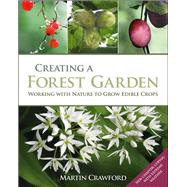Forest Gardening (or agroforestry) is a way of growing edible crops with nature doing most of the work. A forest garden imitates young natural woodland, with a wide range of crops grown in vertical layers. Species are chosen for their beneficial effects on each other, creating a healthy system that maintains its own fertility, with little need for digging, weeding or pest control. The result of this largely perennial planting is a tranquil, beautiful and productive space.
This book is a bible for permaculture and forest gardening, with practical advice on how to create a forest garden, from planning and design to planting and maintenance. It explains how a forest garden is designed from the top down:
- the canopy layer first,
- then the shrub layer,
- the perennial ground-cover layer,
- the annuals & biennials
- next, the climbers and nitrogen fixers
- and finally the clearings, living spaces and paths.
Whether in a small back garden or in a larger plot, the environmental benefits of growing this way are great. Forest Gardens are a viable solution to the challenge of a changing climate: we can grow food sustainably in them without compromising soil health, food quality or biodiversity.
Forest gardens:
- store carbon dioxide in the soil and in the woody biomass of the trees and shrubs.
- enable the soil to store more water after heavy rains, minimizing flooding and erosion.
- boost the health of the ecosystem, ensuring a balance of predators and beneficial insects because mixed planting is crucial to the scheme.
- allows the soil to thrive because it is covered with plants all year round.
Creating a Forest Garden includes a detailed directory of over 500 trees, shrubs, herbaceous perennials, annuals, root crops and climbers. As well as more familiar plants such as fig and apple trees, blackcurrants and rosemary shrubs, you can grow your own chokeberries, goji berries, yams, heartnuts, bamboo shoots and buffalo currants.
Forest gardens produce fruits, nuts, vegetables, seeds, salads, herbs, spices, firewood, mushrooms, medicinal herbs, dye plants, soap plants, and honey from bees.
This book tells you everything you need to create your own forest garden with beautiful illustrations and helpful tips throughout.








